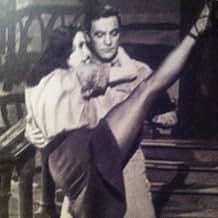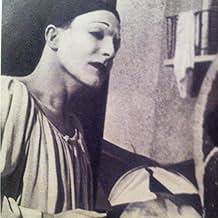IMDb-BEWERTUNG
6,4/10
1097
IHRE BEWERTUNG
Füge eine Handlung in deiner Sprache hinzuThree different stories are told through a notably unusual way - no words, just dance.Three different stories are told through a notably unusual way - no words, just dance.Three different stories are told through a notably unusual way - no words, just dance.
- Regie
- Drehbuch
- Hauptbesetzung
- Auszeichnungen
- 1 Gewinn & 1 Nominierung insgesamt
Luigi Faccuito
- Specialty Dancer
- (Nicht genannt)
Diki Lerner
- Thief in 'Sinbad the Sailor'
- (Nicht genannt)
Paddy Stone
- Speciality Dancer
- (Nicht genannt)
Ian Wilson
- Man Exiting Stage Door in 'Ring Around the Rosy'
- (Nicht genannt)
Empfohlene Bewertungen
Invitation to the Dance is what you get when you take an artist at the peak of his abilities and allow his imagination to run wild. Gene Kelly--and some very talented people in all fields--integrated music and dance to create three distinct stories.
He reduces some scenes to their visual essences by using abstract or minimalist sets, aided by lighting effects. The third story includes cartoons, allowing Kelly to take his imagination beyond the bounds of human limitations and physics.
The performances are a synthesis of various dance and related forms (ballet, tap, jazz, mime, acrobatics, pop, and ethnic) with musical accompaniment (classical, jazz--cool and hot--ethnic, and pop).
Invitation to the Dance is a treat for any dance lover. It should be seen by all young students of dance.
It would be interesting to see this film they way Kelly originally imagined it, with him dancing in one section only.
He reduces some scenes to their visual essences by using abstract or minimalist sets, aided by lighting effects. The third story includes cartoons, allowing Kelly to take his imagination beyond the bounds of human limitations and physics.
The performances are a synthesis of various dance and related forms (ballet, tap, jazz, mime, acrobatics, pop, and ethnic) with musical accompaniment (classical, jazz--cool and hot--ethnic, and pop).
Invitation to the Dance is a treat for any dance lover. It should be seen by all young students of dance.
It would be interesting to see this film they way Kelly originally imagined it, with him dancing in one section only.
Invitation To The Dance took three years to make and it was a labor of love for Gene Kelly. Too bad for him that the public didn't take to it. But it was a film aimed at a highly specialized audience, those lovers of the ballet and other forms of dance.
Around the time that Kelly was winning plaudits for Singing In The Rain he pitched the idea to the MGM studio heads and having just starring in a film that many claim as the greatest musical ever made, he was in a position of considerable leverage. To cheapen costs MGM shot it over in the United Kingdom and this does explain Kelly's appearance in a pair of British films, Crest Of The Wave and The Devil Makes Three while putting together his dance film.
All this is according to the Citadel Film series book on Gene Kelly's films and then because the third and the best sequence was to be done with animated figures like Kelly's famous dance number with Jerry Mouse in Anchors Aweigh, MGM wanted to use Hanna&Barbera their crack cartoonists. Which meant him coming back to the USA to shoot that sequence. All in all it wasn't until 1956 that Invitation To The Dance finally made it before audiences.
The story I found most astounding was Andre Previn who was brought in to score the second sequence about a piece of jewelry making the rounds. MGM didn't like the original score, but the sequence had already been shot. So Previn had to score a ballet which had already been shot with another man's music. No small feat indeed and more production delays.
All this for what was really a film that should have had limited art house release. But MGM didn't do art house type films and they wanted their money back some how.
The three sequences all have Kelly in them, MGM would have it no other way. The first casts Kelly as a Pagliacci type clown in a circus dance drama. The second is as I described before. The third has Kelly as a sailor who gets a magic lamp and a genie appears. It is the best of them.
I'm sure Gene Kelly was disappointed in the lack of applause from a mass audience for Invitation To The Dance. It's a good film, but definitely for a special audience.
Around the time that Kelly was winning plaudits for Singing In The Rain he pitched the idea to the MGM studio heads and having just starring in a film that many claim as the greatest musical ever made, he was in a position of considerable leverage. To cheapen costs MGM shot it over in the United Kingdom and this does explain Kelly's appearance in a pair of British films, Crest Of The Wave and The Devil Makes Three while putting together his dance film.
All this is according to the Citadel Film series book on Gene Kelly's films and then because the third and the best sequence was to be done with animated figures like Kelly's famous dance number with Jerry Mouse in Anchors Aweigh, MGM wanted to use Hanna&Barbera their crack cartoonists. Which meant him coming back to the USA to shoot that sequence. All in all it wasn't until 1956 that Invitation To The Dance finally made it before audiences.
The story I found most astounding was Andre Previn who was brought in to score the second sequence about a piece of jewelry making the rounds. MGM didn't like the original score, but the sequence had already been shot. So Previn had to score a ballet which had already been shot with another man's music. No small feat indeed and more production delays.
All this for what was really a film that should have had limited art house release. But MGM didn't do art house type films and they wanted their money back some how.
The three sequences all have Kelly in them, MGM would have it no other way. The first casts Kelly as a Pagliacci type clown in a circus dance drama. The second is as I described before. The third has Kelly as a sailor who gets a magic lamp and a genie appears. It is the best of them.
I'm sure Gene Kelly was disappointed in the lack of applause from a mass audience for Invitation To The Dance. It's a good film, but definitely for a special audience.
The first two segments of this film may or may not impress you, but do watch the third: "Sinbad the Sailor". Kelly plays an American sailor in an exotic Oriental market. He rubs an old lamp and a genie appears, played by an amazingly talented kid. After a bit of messing around,the genie gets a sailor suit, too. Then they open a book to a picture of a wonderous land. The genie transports them inside and all the rest features the two dancers (mostly Kelly alone) dancing with animation.This segment is much longer than any other live-plus-animation sequence until Mary Poppins excepting, possibly Song of the South whose sequences were nowhere near so complex as this. Kelly dances with an animated dragon (that wraps around him), into a harem, is chased by the Sultan's guards, has a long sequence with one harem girl, and then a very long sequence with the guards. This is amazing work for 1952, especially when you remember that every bit of the animation is hand-painted on cels. Hanna-Barbera (then with MGM doing Tom and Jerry directed the animation. (Kelly also did a famous dance number with Jerry in Anchors Aweigh eight years earlier.) Walt Disney advised. This is swell stuff and any fan of animation should give it a look.
this was Kelly's pet project- a film with dance, and only dance. No dialogue, only mime, movement and music. However to his disappointment, MGM shelved its release and when it was the film was released badly- it was too arty farty to be popular with the audiences at that time. Well, I love this film. It's adventurous and interesting, and it's worth a watch to appreciate all the work Kelly's put into this work, which showcases some of the greatest dancers across many styles. So go watch this under-rated film and you will be in awe of all the talent shown before your eyes!
It might better have been called "Invitation to the Pantomime" because there is no speaking, much less singing, in the film, a production much better suited to the stage. The movie does in fact look like a filmed stage production, and the format and ambitions of the film are not what audiences had come to expect from Gene Kelly. But this was his baby, and he wanted to take filmed dance to entirely new levels of artistic achievement. In many ways, it is a testimony to his power as a choreographer and a star that he was able to pull it off. Nevertheless, beautiful as it is, this is not everyone's cup of tea. Watching the first of the three dance sequences, I longed for Kelly to take that white paint off his mime face and stop mooning over the ballerina. He did, and the next two sequences are more enjoyable, the last being rather fun when animation takes over. ---from Musicals on the Silver Screen, American Library Association, 2013
Wusstest du schon
- WissenswertesGene Kelly's original intention was to make a film that would educate mainstream audiences about professional dancing in the world. To this end, he wanted to cast the greatest dancers in Europe for the four segments in leading roles. He himself would appear in only one - the Popular Song sequence, which ended up being cut. MGM, however, refused to allow the picture unless he appeared in all of them. Many of the professionals who worked in the film agreed that this was one of the film's great weaknesses.
- PatzerDuring the "Scheherazade" sequence, the color of the palace guard's costume changes from green to blue.
- VerbindungenEdited into American Masters: Gene Kelly: Anatomy of a Dancer (2002)
- SoundtracksCircus
Music by Jacques Ibert
Performed by The Royal Philharmonic Orchestra, conducted by John Hollingsworth
Danced by Gene Kelly, Igor Youskevitch and Claire Sombert
Top-Auswahl
Melde dich zum Bewerten an und greife auf die Watchlist für personalisierte Empfehlungen zu.
- How long is Invitation to the Dance?Powered by Alexa
Details
Box Office
- Budget
- 1.500.000 $ (geschätzt)
- Laufzeit
- 1 Std. 33 Min.(93 min)
- Seitenverhältnis
- 1.37 : 1
Zu dieser Seite beitragen
Bearbeitung vorschlagen oder fehlenden Inhalt hinzufügen
































